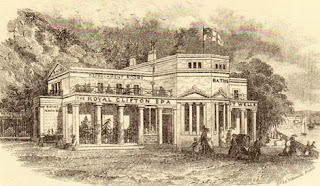In 1836 the Gentleman’s Magazine carried the
following item in its Obituaries column:
Feb.
19. At the Hotwells, Clifton, aged 36, the Rev. John Warne, priest vicar of
Exeter. He was of Trin. coll. Camb., BA 1823, MA 182-. [sic]
That was that,
then. More of an announcement than an obit. Was there really nothing more to
say about the late John Warne, my 3x great uncle? Was he not even worth
discovering the date of his MA for?
We do know a
little bit of his clerical career, which was remarkably unspectacular. He was a
minor canon in Bristol, and a curate in the posh Bristol suburb of Clifton until
on the 6th June 1830 he was (as the Hampshire Chronicle reported the following day)
collated
by the Dean and Chapter of Exeter, to a Priest Vicar's Stall in their
Cathedral, void by death of the Rev. Wm. Tanner.
Not by his own
merits alone but by the death of poor old William Tanner!
Exeter Cathedral in 1830
Curate, minor
canon and priest vicar are all variations of the same relatively junior role in
the hierarchy of the Church of England. A curate was the local bishop’s
man-on-the-spot, the cleric in charge of a particular church or parish – only after
1868 were such ministers formally known, as they are today, as vicars. A minor
canon (for which priest vicar is simply another name) fulfilled the same tasks
as a curate, but as part of a team of such clerics in a larger church or
cathedral. Often they also had a choral role, leading the singing of high
church calls and responses. Perhaps John Warne had a talent there, a sweet
spiritual voice. But in a cathedral diocese they were the foot soldiers of the
bishop, never part of his inner circle or chapter. So it was at Exeter
Cathedral, and there John Warne remained until his own death six years later.
His death – so often
it is the manner of one’s departure that leaves the greatest impression; and,
in the absence of much other information, so it is with Warne. The Hotwells of
Clifton at which he died were, as the name implies, hot springs at the base of
the cliffs of the Avon Gorge, now crossed by the Clifton Suspension Bridge.
They have been known since at least the fifteenth century and the first attempt
to harness their commercial potential came with the erection of a pump room in
1696.
The original Hotwells pump room, demolished in 1822
The original building
was replaced in 1822 with Hotwells House, and a grand new pump room, based on
those in Leamington and nearby Bath which Bristol hoped to rival. Presumably
John Warne had some ailment which he thought would be improved by bathing in
the warm waters. In the fifteenth century they were believed to cure scurvy; in
the seventeenth, they were recommended for “hot livers, feeble brains and red
pimply faces.” Warne’s death while actually visiting the spa cannot have been
good for business. Perhaps he was simply overcome by the heat.
Hotwells House and pump room (1822)
The Hotwells’
location at the Avon Gorge was considered one of the most dramatically picturesque
in England, and the spa had some success in attracting patrons to its supposedly
restorative waters (later shown to be rather polluted). But it never competed
with Bath, and Bristol’s real wealth was generated not by tourists at Hotwells
Spring but by ships on the River Avon. If it was to continue to be accessible
to ever-larger vessels, the port of Bristol needed to straighten the river bend
on which the spa stood, and in 1867 the city’s merchant princes demolished the entire
complex and the land it stood on.
If John Warne’s
death is the most interesting thing about his life, it is not his greatest
legacy. In 1832 he married Mary Laura Elizabeth Acraman (1802-1876), my 3x
great aunt and a member of a prominent Bristol family of ships’ chandlers. In
1833, before the onset of whatever illness led him to the Hotwells, the couple
had their only child, a daughter Elizabeth Ann. In time Elizabeth married and
had children of her own. Mary Warne never remarried but, remaining in Clifton
on a clergyman’s widow’s pension, outlived her husband by forty years.








No comments:
Post a Comment